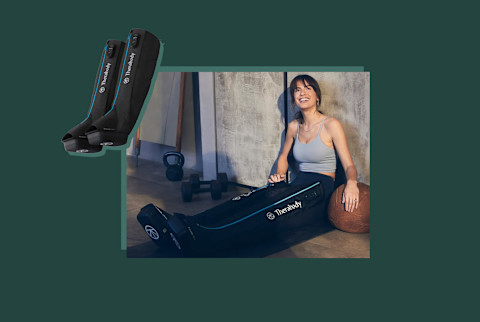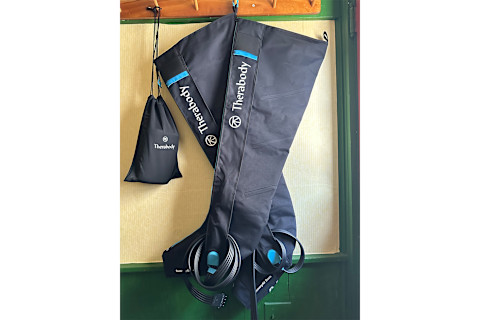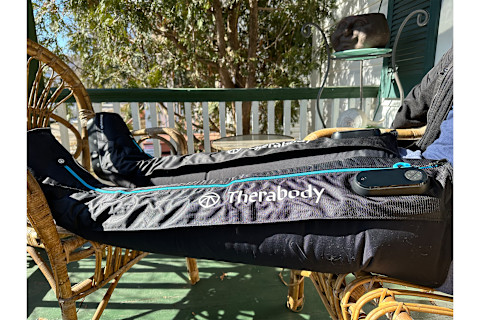Therabody RecoveryAir Compression Boots Review, From A CPT

Whether your movement of choice is a round of high-intensity boxing or bending your way through a hot yoga class, the magic happens during the hours and days post-workout. Studies suggest compression tools may help reduce fatigue, combat soreness1, and improve muscle recovery. Read our Therabody RecoveryAir Compression Boots review to decide if this recovery tool is right for you.
Compression levels:
9Body parts:
LegsSizes:
S, M, LBattery Life:
3 hoursWarranty:
60 daysWho should use Therabody compression boots?
Compression boots were originally designed for use in hospitals for individuals with circulatory issues. Now, they're used by competitive athletes in a variety of sports, including runners, cyclists, weightlifters, and swimmers. “Compression boots can also be helpful for individuals who spend long periods standing, such as nurses, teachers, or waitresses,” says Radermacher.
Who shouldn’t use the Therabody compression boots?
Not sure if compression boots are right for you? It's always best to discuss any new addition to your routine with your primary healthcare provider.
What are compression boots?
The best compression boots, such as Therabody's RecoveryAir, use intermittent pneumatic air pressure to improve circulation and reduce leg swelling. These boots are becoming increasingly popular with athletes looking for ways to recover more efficiently and individuals with circulatory issues, according to Grant Radermacher, doctor of chiropractic at Ascent Chiropractic in Brookfield, Wisconsin.
"Therabody's RecoveryAir boots cover your entire legs, extending all the way from your feet up to the top of the thighs. They mechanically inflate and deflate segments of an air sleeve to effectively give you a full-leg deep-tissue massage, increasing blood flow to your legs and helping reduce soreness, swelling, and fatigue," Radermacher explains.
The benefits of compression therapy
Radermacher explains that muscles continually produce metabolic waste as they generate and use energy. This waste (specifically, hydrogen ions and reactive oxygen species) is then circulated throughout the bloodstream.
The lymphatic system is responsible for getting rid of metabolic waste. However, since your legs are situated below the heart, it is more challenging for your circulatory system to move waste from your legs to your lymphatic system. Enter: compression therapy.
"The concept behind compression boots is pretty straightforward—compression aids blood flow through the legs, which, in turn, facilitates the circulation of metabolic waste, allowing the body to dispose of it more efficiently," Radermacher says. The faster your body can get rid of metabolic waste (and bring new nutrients to your muscles), the quicker they can repair and rebuild.

What sets Therabody compression boots apart?
When comparing Therabody's RecoveryAir Compression Boots to classic compression socks, Radermacher says there's no competition. Compression socks are designed to squeeze the legs without any movement or variation in pressure. Compression boots offer active compression and allow the user to control the amount of pressure applied.
"It's akin to the difference between an active and a passive stretch, as the mechanical devices provide a significantly higher degree of compression and work exponentially faster than socks," Radermacher adds.
Covering the entire lower body, compression boots are more effective and convenient than systems that work on a single ankle, knee, or elbow. Therabody's RecoveryAir compression boots are equipped to work on both legs simultaneously.
Radermacher points out that the RecoveryAir edges out the competition by utilizing precise pressures based on the size of the limb within the sleeve to prevent over-compression, which can cause discomfort, numbness, and tingling in the compressed area.
The RecoveryAir also has a smoother, more gradual compression as it moves up the leg compared to those that fill each section individually, he says.
What our testers love about the Therabody compression boots
Our tester, Andreas Von Scheele says the Therabody RecoveryAir Boots are an amazing addition to any athlete's recovery routine. He describes the sensation as feeling like "a boa constrictor is hugging your legs, but in a good way."
His favorite part? The fact that you can adjust the strength of compression, making it as intense or gentle as you want. While he prefers to crank it all the way up, others on our team like to use compression boots on a lighter setting. Von Scheele reports a noticeable relief for his tired muscles, adding that the boots feel well designed, the materials feel very durable, and the controls are easy to use.
After putting them to the test for a few weeks, he says the Therabody RecoverAir boots offer faster recovery and a generally relaxing experience. Pro tip: Make sure you have the remote control in hand before you get settled in.
How to use compression boots
Compression boots can be used as part of your post-workout recovery routine or on rest days. If you don't have time to use them every day, reserve them for after your most strenuous workouts. "The more work you do, the more recovery you need," Radermacher explains.
"The harder the effort, the more metabolic waste your muscles produce that needs to be cleared. So, compression boots are particularly helpful after your most taxing, strenuous workouts."
If you train every day, Radermacher recommends using the boots three to four times per week, for 30 to 35 minutes at a time. "Most individuals should keep the pressure below level 7 or 8 on the pressure dial," he says. "A tingling or numb sensation in your feet means the pressure's too high, and if you can see depressions from the seams of the boots on your legs after you're done with a session, you should probably back off on the intensity."

Factors to consider when shopping for a compression boot:
- Pressure level/intensity settings: We learned through testing that everyone prefers a different level of intensity. When using compression boots, intensity is typically measured in millimeters of mercury (mmHg), indicating how tightly the boots will squeeze your legs.
- Body parts: The Therabody RecoveryAir Compression Boots cover both legs. When deciding if these are right for you, think about what area you want to treat.
- Portability: Compression boots range in size—but those that cover your entire lower body will be larger than those that only cover a small area. The Therabody RecoveryAir Compression Boots are fairly easy to fold up and transport.
- Price: Consider your budget before deciding whether these boots are right for you. Just remember, recovery is just as important as training.
Therabody Recovery Air Boots pros & cons
- Multiple sizes for custom fit
- Smooth, gradual compression
- Manual and preset controls
- Durable
- Fewer advanced features than other options
- Remote control is separate

FAQ:
How many times a week should you use compression boots?
While there is no harm in using compression boots every day, you can start with three or four sessions per week, depending on your workout intensity and frequency. Even once per week after your most intense leg session or long run can be helpful.
Can you overdo compression boots?
While no studies suggest that you can overdo compression boots, it's wise to listen to your body. If you experience any tenderness or bruising, back off on using the boots as often.
Do compression boots help with inflammation?
Most research shows that compression boots do not help with muscle inflammation, although that may be a good thing. The inflammatory response after a workout helps the body repair and adapt, growing bigger and stronger muscles, and should not always be stopped. However, compression boots do help reduce swelling or edema and improve blood flow, which is beneficial for recovery.
When should you not wear compression?
Not sure if compression boots are right for you? It's always best to discuss any new addition to your routine with your primary health care provider.
Do compression boots help lymphatic drainage?
Compression boots help with lymphatic drainage and are used to treat lymphedema. Research suggests that regular treatments can help improve lymphedema in those who experience it.
The takeaway
Compression boots are an extremely beneficial recovery tool to keep in your arsenal, especially for those intense leg workouts, sprints, and long runs. These Therabody RecoveryAir Compression Boots increase blood flow, helping to deliver more nutrients to needy tissues, and may reduce pain and swelling. If you'd like to learn about other compression boots on the market, check out our team's top picks.


